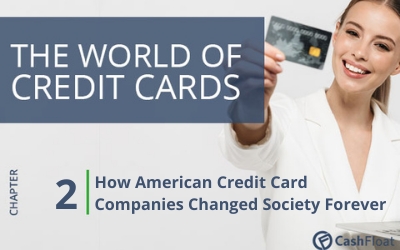If you haven’t read chapter 1 of our guide, then it will be news to you that the first credit cards came from America. The foundations laid by these first cards still affect how we all borrow money on credit today! Read on, with Cashfloat, for more of the fascinating history of the American credit card and to find out how credit works in America today.


- Read amazing stories about crime in the early days of American credit cards
- Find out how casual people were with credit in the 80s and 90s
- Discover out how this led to the astonishing levels of debt that triggered the 2008 financial crisis
- Find out how credit card companies have been restricted to prevent this from happening again
As we explained in chapter 1, the US was the place where the revolutionary change from saving to spending on credit first began. The social changes, which were caused by the use of credit in the US, have also taken place in the UK and plenty of other parts of the world. Read chapter 1 for an in-depth explanation of how credit cards emerged in the US.
In this chapter, we’ll start by briefly recapping how credit cards first started in America and share a few more fascinating stories from the early days of credit. After that, we’ll explain how credit cards went on to boost the US economy in the latter part of the twentieth century and then crash it at the start of the 21st century.
All of this history influences how credit cards work today and, after we’ve fully explained how credit cards came to exist, we’ll explain the basics of how the modern American credit system works. We will take a look at how US credit card companies work and, in particular, what interest rates and fees they charge. After that, we will look at the current levels of borrowing and debt in American society. While credit has had many positive influences on the economy, debt levels give the starkest indication of the negative impact that credit cards can have on society.
American Credit Card History
Although credit cards were first introduced in the US in the 1950s, the use of this method of payment only became mainstream in the 1980s. As the use of credit cards grew, the rise in consumer debt, which had previously been associated with a weak character, became accepted as part and parcel of normal everyday living.
Bringing huge profits to the financial sector as well as a healthy increase in the retail industry, credit cards were very influential in the growth of the economy of the US. While they helped to cause a boom for a long period of time, they were also partly responsible for the woes that beset the financial sector during the credit crash of 2008. Read on below.
Early US Credit Card History in Brief
Here’s a brief recap of the early days of credit cards.
Just as in the UK, in the US there was not much in the way of credit available for ordinary people before the early part of the twentieth century. Local stores sometimes allowed farmers or businessmen to run up a tab so that they could buy essentials to last until their goods were sold, when they could settle their account. However, there was no universal credit system in operation.
One of the earliest forms of credit came from retail stores who offered purchases on credit. Customers were allowed to buy goods and then pay for them later, in installments, at a slightly inflated price. The success of schemes like this led to their expansion and introduction in more retail stores. Charge cards also emerged for some members of society, particularly for businessmen who worked for large companies. These early forms of credit were quite exclusive and only available to a limited number of people. While they had a limited impact on society, they helped to lay the foundations for the development of credit cards.
The Diners Club card was introduced in the early 1950s and this was less exclusive than previous credit schemes. As more and more people were able to sign up to this scheme (which allowed people to pay for meals in popular restaurants on credit provided by a charge card), this paved the way for the widespread introduction of charge cards. Following the success of the Diners Club card, American Express introduced charge cards which could be used to purchase many types of goods. These, again, were even more accessible to the general public and the fact that they could be used to pay for goods in a variety of situations was revolutionary. An industry began to develop and the terms and conditions of charge card usage were gradually changed until they became what people now know as credit cards.
A Credit Card Crime Story – The Chicago Debacle
In the 1960s, credit card companies used to mass-mail pre-approved cards to people as a sales technique. Recipients would receive a credit card already approved and registered to them in the post and many would be tempted to use it. In 1966, one such mailing went out to the residents of Chicago when a number of different companies tried the same marketing technique at the same time. Unfortunately, an organised crime group heard about the mailing and bribed some postal employees to intercept the cards.
The result was the Chicago Debacle with hundreds of people receiving bills for goods that they had not bought on accounts that they had not opened. This was the first large-scale attempt at identity theft in the credit industry. It was a hugely influential factor in ending the practice of mailing out pre-approved credit cards. Watch this fun video for a detailed look at what actually happened.
The mass mailing of credit cards, which often went out to people who already had debt problems, health problems or were unemployed officially ended in 1970. This was after President Johnson’s special assistant likened the practice to ‘giving sugar to diabetics’ and the government sought to end the imminent financial chaos that they could envisage happening.
The 20th Century Credit Card Boom
Here’s how credit cards really took off in the latter part of the 20th century and an explanation how this change affected the economy of the US.
The Effect of New Technology on Credit Cards
In the 1970s, as technology was fast evolving, the credit card industry began to embrace new systems of operation. These allowed companies to work more efficiently and to operate all over the United States, rather than in local areas. As this happened, the national credit industry gained strength and national standards were introduced.
Prior to this period, state laws regarding interest rates were hampering the American credit card companies. Inflation was running high, but in some states, the interest rate was set too low for companies to profit from their cards. This meant that customers were charged rates according to the state they lived in, instead of where the company was located.
New laws allowed credit card interest rates to be set at the rate of the state in which the company was located. This caused some companies to move their headquarters from low rate states to high rate ones. One such company was Citibank which moved from New York to South Dakota. This allowed them to charge an interest rate of 20%, which was more in line with the inflation rate of the time. The state with the least interest rate regulations became the benchmark for credit card companies. As technology continued to surge ahead, the credit card industry became truly national and then truly global.
In the mid 1970s, transaction times were reduced to one minute instead of taking around 5 minutes while the slip was signed, the signature checked and multiple pieces of paper and ID were exchanged. This era was followed by the golden age of credit during the 1980s when the use of credit cards really took off.
The introduction of online banking technology, later in the 1990s, was another major technological advance for the credit card industry. As well as increasing credit card uptake, this also led to the rapid growth of the payday loans online industry, both in the US and elsewhere in the world.


The Golden Age of Credit Cards
Many people agree that the golden age of credit cards was from the 1980s up to the financial crisis of 2008. During this period in the US, saving rates declined and there was an increase in the forceful marketing of cards. As house prices continued to rise, credit finally became socially and culturally acceptable to most people. Credit card debt was on the rise.
In the not too distant past, the ordinary American citizen had viewed debt as almost abhorrent. This was because many remembered the Great Depression of the 1930s. During the Great Depression, the US experienced its worst ever economic crash. During this time, unemployment rates were incredibly high, there were reports of starvation and hunger and many people were forced to migrate to look for work at very low rates of pay in order to survive. After this, people had a hard attitude towards anything which could be considered financially foolhardy and heavily criticised those who were seen to be taking risks.
Throughout the 80s, 90s and early 00s, credit cards were used all over the place. Many of us today will remember the aggressive sales tactics of credit card companies and the casual attitude that many people had towards debt. How many of us know someone who was using one credit card to pay off another one? Credit was easy to get hold of and many people lived their lives with a high level of debt.
Have a look at this 1990 credit card advert for an idea of how casual people were about using credit cards during their golden age:
The Financial Crisis of 2008
By the middle of the first decade of the new Millennium, many Americans had little or no savings and some were tens of thousands of dollars in debt. As credit cards gained popularity, so did other forms of credit such as short term loans. The culture of living in debt had reached its peak. Not only were the public not afraid of being in debt, but it seemed that banks, mortgage providers and credit card companies had no fear of loaning to people as well. Many people will be familiar with the fact that subprime mortgages contributed to the financial crash of 2008. These were huge mortgages given to people with low credit ratings.
This change in the style of living had led to huge profits for the financial companies issuing credit cards, as well as companies who provided other types of loan.
The increase of credit card use meant that consumers were living too far beyond their means. The credit card industry kept growing until the financial crisis that hit the whole world in 2008 happened. This crash is considered by many to be the most severe economic crash since the Great Depression of the 1930s. Unemployment rates skyrocketed, many businesses went under and the whole world was plunged into an economic crisis, which lasted for many years. Many had to rely on payday loans for unemployed people to get through the month, but these were unregulated at the time and caused many to fall into deep debt traps.
After the 2008 crash it took many years for the economy to recover. Credit card companies had suffered many defaults on payments and initially they became more selective in who they gave credit cards to. As a result of this, payday loans started rising in popularity. Since the economy has recovered, credit card availability has become more widespread again. However, many people are reluctant to use them and payday loans have kept some of the popularity that they gained.
Modern Credit Cards in the United States
Credit Card Interest Rates in the US
The interest rates provided by credit card companies in the US are set according to several different considerations. Often, the main considerations are the credit history of the applicant and whether or not the applicant has secured the card with an asset, such as their home or a business. Companies will also have to take into account the age, marital status and various other personal details of the applicant. Alongside this, they will have to make considerations about regional differences in earning potential and national and international economic conditions.
Typically, in the US, rates stand at around 16.15% according to data from credit card comparison websites. In the UK, rates are typically higher at around 20-21%. As with short term loans in the UK, the interest rate is expressed as an APR (Annual Percentage Rate) as well as in EAR (Effective Annual Rate). You will learn more about how to approach interest rates on credit cards in Chapter 6.
Credit Limits in the US
Just as in the UK, credit scores play an important part in the amount of credit each account holder has access to. The FICO scoring system is commonly used in the US and this system creates a credit score, for each individual, based on several different factors. The factors which are taken into account are the person’s existing debt and payment history, their length of recorded credit history, any new credit accounts they have recently taken out and what mix of types of credit they own already. After all these factors are considered, a person is given a score. The higher a person’s score, the higher credit limit they are likely to be given.
Data from Bankrate in 2020 showed that average credit limits in the US (by age group) ranged from $8,062 for people aged 18-22 to $39,919 for people aged 55-73. Those aged 23-38, had an average credit limit of $20,647, for those aged 39-54 this was $33,357 and for those aged over 74, it was $32,338. While those may be the average figures, as many as a third of Americans may be considered subprime borrowers. For subprime borrowers, credit limits can be as low as $500 and the fees for taking out cards are often restrictive.
Fees And Charges On Credit Cards In The US
Fees and charges applied to credit cards are not just for late or missed payments. Many credit cards charge an annual fee just to have access to credit. These fees normally range from $25 to $600. Cards with a high fee usually offer benefits with the card, such as free air miles or free purchases. The American Express Centurion Card charges an annual fee of $5000 and offers the best in perks, freebies and access to special offers.
It is advisable that anyone opting for a card with an annual fee should always make sure that the benefits outweigh the annual charge. And, this applies to the UK as well as the US.
Some companies divide the fee up into monthly payments, and some charge on an annual basis. It is quite common for new customers to have the fee waived in the first year and then, after that, the company starts to make the charge. Often credit card companies know that new customers will aim to stop using the card before they have to pay a fee. However, they hope that their customers will inadvertently have an outstanding balance on their account and will be unable to close it, and then end up being drawn into paying membership fees as well as interest on the money that they owe. So be careful.
Changes to US Credit Card Regulations
In 2009, following many complaints about the credit card industry, the US Congress passed the Credit Card Accountability Responsibility and Disclosure (CARD) Act of 2009. They designed the Act to make sure that credit card customers had a variety of safeguards. These included minimum times to pay off accounts, rules against companies increasing interest rates retrospectively and rules that made it easier to pay off debts by applying payments to the transactions that had the highest rates of interest. The Act did not include any rate capping, fee capping or price controls.
In addition to the rules already mentioned, another rule restricted credit card companies from charging high fees to bad credit customers, and there was also a restriction on fees for prepaid cards. Finally, the Act was also designed to prevent excessive marketing to young people and companies were forced to make sure that new customers under 21 had an independent income before they were allowed a credit card.
In the past, credit card companies sometimes charged prepayment penalties and fees if customers made more than one payment per month. Prepayment penalties were when customers were charged a penalty for paying off their outstanding balance before a certain date. However, the US government has also tightened the rules about prepayment clauses and early payment fees and many of these previous practices are now illegal.
Credit Card Debt in America
Millions of Americans own credit card debt. In the year 2000, during the golden age of credit cards, over half of all American households had credit card debt. This number has fallen slightly since then, but many still have credit card debt. Just like in the UK, there are debt charities around America who aim to help those who have run up large amounts of debt. The leading debt charity in the UK is StepChange. If you are struggling with debt, you can go to StepChange or another debt organisation for help and advice.
Who has the highest debt?
According to the Federal Reserve for Consumer Finances, those who owe the highest amounts in debt in 2021 are those aged between 45 and 54 years, and those aged over 74. 51.7% of those aged 45-54 had some form of credit card debt and the average amount for this age group was $7,670. Those aged 35-44 were not far behind with 50.5% of people having credit card debt, at an average amount of $5,990. Those aged over 74 had the highest average debt at $8,080, but only 28% of people had debt.
As you might expect, those with larger incomes had the highest amounts of debt. However, levels of debt were still high in people on low incomes. According to the Federal Reserve Bank of New York, the level of credit card debt has generally decreased since the golden age of credit in the US. In the year 2000, total credit card debt in America was $693 billion. This grew to a record high of $858 billion just before the 2008 financial crash. Since then credit card debt has fallen. Their latest figure, from 2014, was $680 billion. This is lower than the 2000 total, despite the effect of inflation. While credit card debt may have fallen, other forms of debt have risen. In the year 2000, total consumer debt was $7,555 billion and in 2014 this was $11,710 billion. This suggests that people are turning to other lenders for credit.
American Credit Cards – Summary
If you find finance interesting, the story of how American credit card companies first began and how they evolved into what they are today is fascinating. What we’ve discussed here, in chapters 1 and 2 of this guide, is just a short history of the most important events and facts. If you want to find out more, then why not read more about it yourself. American Express have published an interesting timeline of their history, which is available here. As have Visa, which is available here. If you want to find out about credit card fraud, then a good place to start is Wikipedia’s article on credit card fraud. This details the biggest frauds in history and also tells you how modern scams operate today.
Coming up in Chapter 3:Read on to chapter 3 to find out how credit cards became established in the UK with the Barclaycard. Find out how the UK’s credit card industry developed and how we all came to copy American spending habits.



